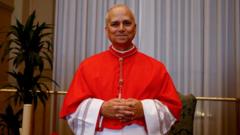The election of Robert Francis Prevost as Pope Leo XIV signifies a transformative moment for the Vatican and its engagement with global issues.
Pope Leo XIV Emerges as First American Pontiff, Shifting the Global Catholic Landscape

Pope Leo XIV Emerges as First American Pontiff, Shifting the Global Catholic Landscape
Historic Election Marks New Era for the Catholic Church
May 8, 2025, marked a significant day in Catholic history as Robert Francis Prevost was elected as the 267th pope, now known as Pope Leo XIV, becoming the first pontiff from the United States. The election was conducted by 133 voting cardinals and resulted in a plume of white smoke rising from the Sistine Chapel after just two days of voting. Prevost's selection defies previous expectations that the church would shy away from choosing a leader hailing from a world superpower like the U.S., which already wields substantial influence on global matters.
Pope Leo XIV stands poised to disrupt the existing Catholic hierarchy, particularly as he represents a contrasting view to the conservative Catholicism prevalent in the U.S. His history is one of transcending borders—after being born in Chicago, he spent twenty years serving in Peru where he not only became a bishop but also a naturalized citizen. His extensive experience includes leading an international religious order and managing the selection of bishops in a crucial Vatican role under Pope Francis.
Prevost’s background could enable him to bridge the various factions within the Church while also addressing contemporary challenges faced by Catholicism today. The Roman Curia, eager for stability following various turbulent leadership changes under Pope Francis, sees in him a figure well acquainted with the bureaucratic dynamics of the Vatican, which could prove essential for his governance.
With the appointment of Pope Leo XIV, observers are hopeful for a revitalized Church that can more effectively navigate the complexities of modern society and its deep-seated issues.
Pope Leo XIV stands poised to disrupt the existing Catholic hierarchy, particularly as he represents a contrasting view to the conservative Catholicism prevalent in the U.S. His history is one of transcending borders—after being born in Chicago, he spent twenty years serving in Peru where he not only became a bishop but also a naturalized citizen. His extensive experience includes leading an international religious order and managing the selection of bishops in a crucial Vatican role under Pope Francis.
Prevost’s background could enable him to bridge the various factions within the Church while also addressing contemporary challenges faced by Catholicism today. The Roman Curia, eager for stability following various turbulent leadership changes under Pope Francis, sees in him a figure well acquainted with the bureaucratic dynamics of the Vatican, which could prove essential for his governance.
With the appointment of Pope Leo XIV, observers are hopeful for a revitalized Church that can more effectively navigate the complexities of modern society and its deep-seated issues.























